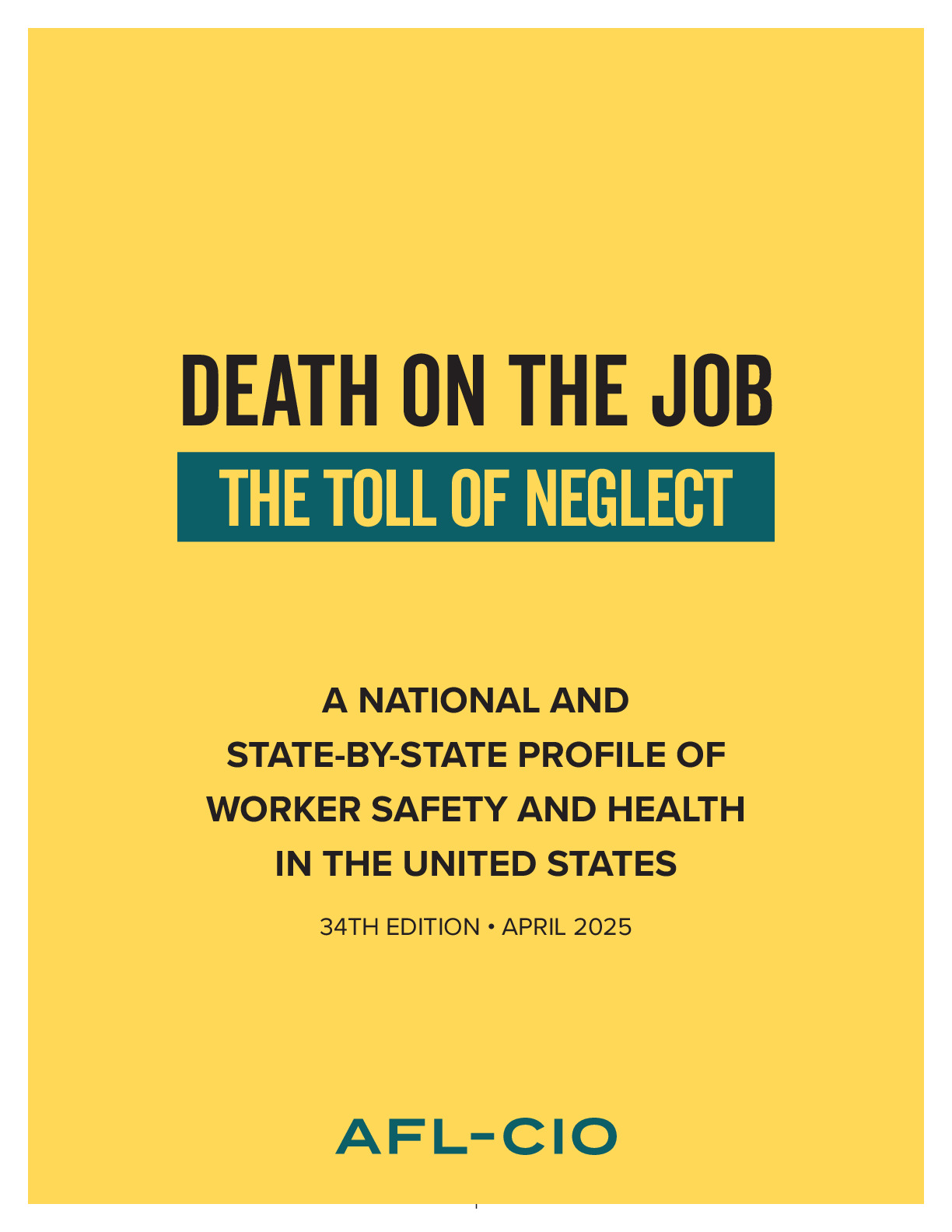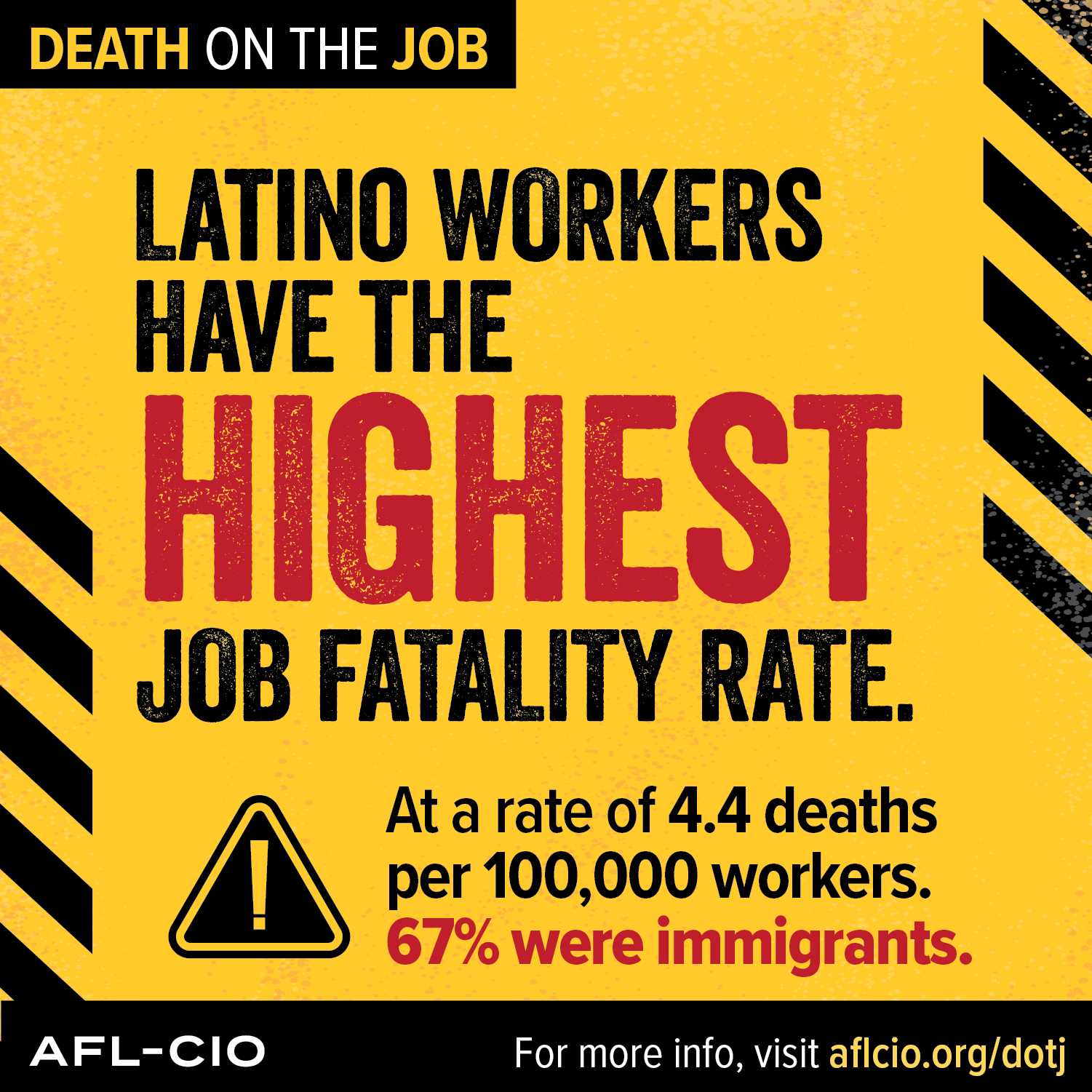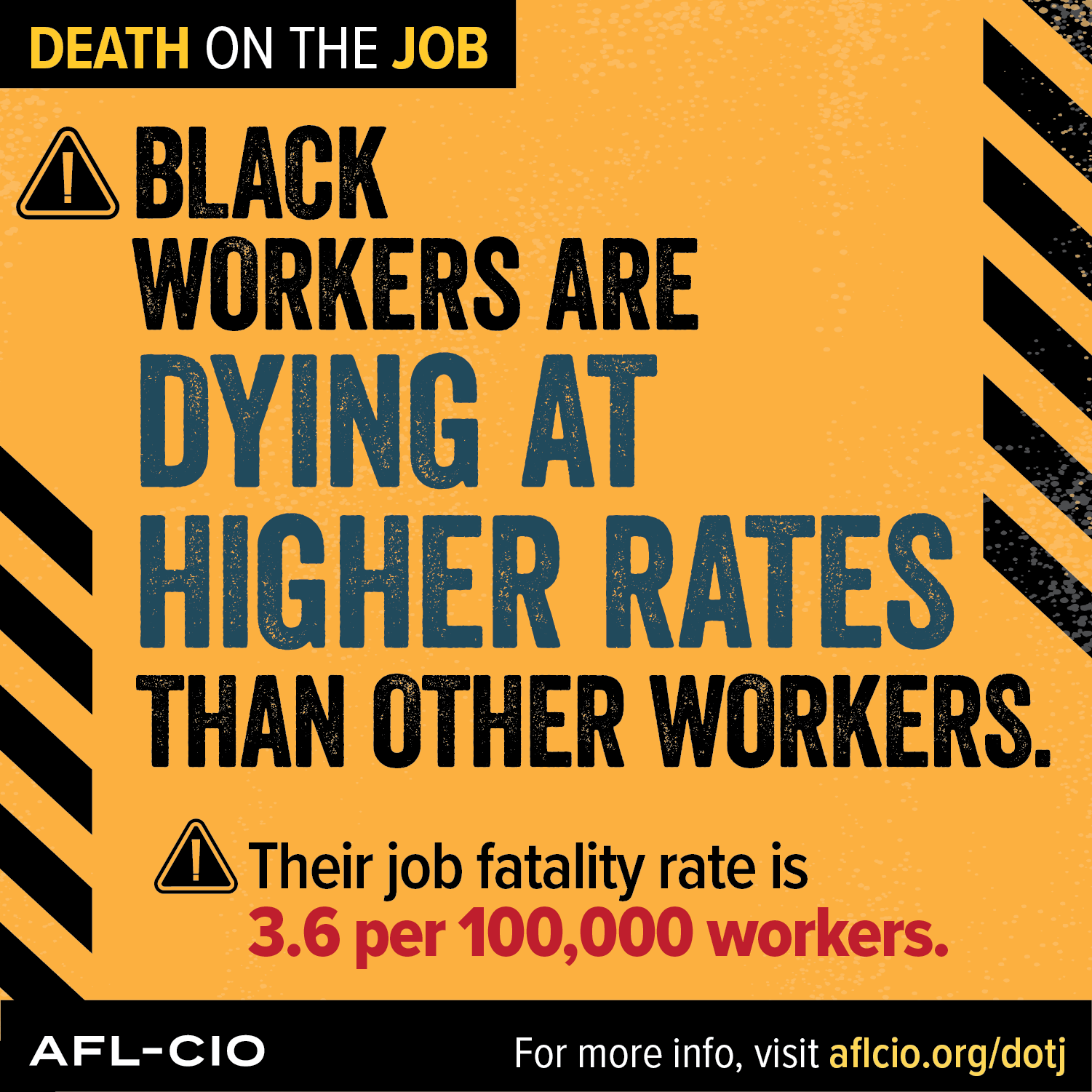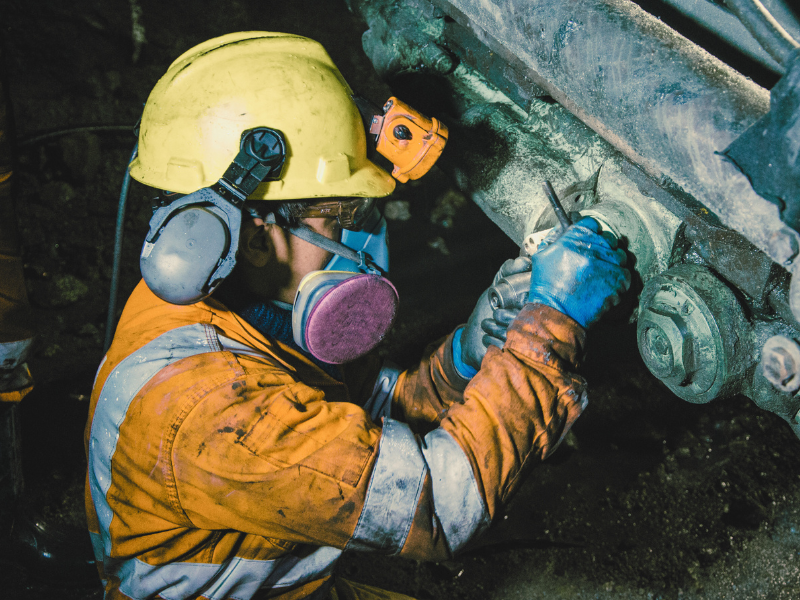Executive Summary
This 2025 edition of “Death on the Job: The Toll of Neglect” marks the 34th year the AFL-CIO has produced the only comprehensive report on the state of safety and health protections for America’s workers. This report features national and state information on workplace fatalities, injuries and illnesses, as well as workplace safety inspections, penalties, funding, staffing and public employee coverage under the Occupational Safety and Health Act (OSH Act). It also includes information on the state of mine safety and health, key topics such as workplace violence, musculoskeletal disorders and heat illness prevention, and transitions in policies on government occupational data reporting, transparency and equity.
This report focuses on the most recent data available from several different sources: job fatality, injury and illness data from 2023, and enforcement data from FY 2024.
Fifty-four years ago on April 28, the OSH Act went into effect, promising every worker the right to a safe job. More than 712,000 workers now can say their lives have been saved since the passage of the OSH Act. The federal Mine Safety and Health Act was enacted 48 years ago. Since that era, workplace safety and health conditions have improved. But too many workers remain at serious risk of injury, illness or death as chemical plant explosions, major fires, construction collapses, infectious disease outbreaks, workplace assaults, toxic chemical exposures and other preventable tragedies continue to permeate the workplace. Workplace hazards kill approximately 140,000 workers each year—including 5,283 from traumatic injuries and an estimated 135,000 from occupational diseases in 2023. That is 385 workers each day—and many worker protections are under threat. Job injury and illness numbers continue to be severe undercounts of the real problem.
Over the years, our progress has become more challenging, as employers’ opposition to workers’ rights and protections has grown, and attacks on unions have intensified. Big corporations, many conservatives and billionaires have launched an aggressive assault on workers’ lives and their livelihoods by repealing job safety and health regulations, promoting deregulatory initiatives, blocking funding and pulling back resources for job safety agencies, firing federal staff doing critical work to protect worker health and safety, and requiring additional burdens in order to issue protections at all. They aim to dissolve the protection structures and shift the responsibility for providing safe jobs from employers to individual workers, and to undermine the core duties and capacity of workplace safety agencies, and more recently disregard and discard the government’s responsibility to protect workers altogether.
President Trump’s first 100 days of his second administration have not only attacked Biden administration progress, but confirmed his anti-worker, pro-business philosophy. 1 Since taking office at the end of January 2025, he has issued dozens of executive orders to roll back or review existing regulations, including an order that requires that for any new regulatory protection issued, an agency must remove 10 safeguards from the books. He has empowered Elon Musk and his so-called “Department of Government Efficiency” (DOGE) to launch a full-scale attack on workers by eliminating entire government agencies, removing the independence of other agencies, and firing tens of thousands of federal workers under the guise of eliminating waste, fraud and abuse. Although no significant waste, fraud or abuse has been identified in federal agencies, Trump and Musk have used DOGE to launch attacks on workers’ rights, workers’ protections, federal agencies, and private and public sector unions.
The Trump administration and DOGE have focused on totally decimating the fabric of what makes government protections work for people through attacks on job safety, public health, union rights and the independence of federal agencies. Attacks on federal workers aim to decimate the fairest employer in the country; it is not a coincidence and it is not efficient. There is no misunderstanding among workers and unions that state and local governments and the private sector will be next on the chopping block. In the most poignant and direct attack on worker safety, DOGE functionally eliminated the National Institute for Occupational Safety and Health (NIOSH), the only worker safety and health research agency. Worker safety is not a priority for this administration.
National progress over the decades has undoubtedly made workplaces safer and saved lives. But that progress is under attack, now more than ever. The nation’s workers now must fight fearlessly to hold onto worker protection and public health systems, as they did a century ago to create these agencies, laws and standards that keep us safe at work. We must prioritize protecting workers from job injury, disease and death, restore dignity and justice to working people, improve livelihoods, and reduce burdens on families and communities, over the whims and greed of billionaires. Employers must meet their responsibilities under the law to protect workers and be held accountable when they put workers in danger.
There is much more work to be done to ensure the fundamental right to a safe and healthy job is a reality for all of America’s workers.
The High Toll of Job Injuries, Illnesses and Deaths
In 2023:
- 385 workers died each day from hazardous working conditions.
- 5,283 workers were killed on the job in the United States.
- An estimated 135,304 workers died from occupational diseases.
- The overall job fatality rate decreased to 3.5 per 100,000 workers.
- Workers of color die on the job at a higher rate: Black and Latino worker job fatality rates are disproportionate compared with all other workers and they continue to remain high.
- Employers reported nearly 3.2 million work-related injuries and illnesses, a decrease from the previous year.
- At least 55 workers died from heat on the job, a 28% increase from 2022; fatal and nonfatal data are an undercount of the real problem.
- Workplace homicides continue to be a significant problem, even though they decreased 12.6% since 2022; workplace suicides increased 5.2% from 2022.
- Separately, unintentional overdoses at work decreased nearly 5% from 2022 to 2023, due to increased attention paid to and efforts to combat the opioid crisis.
- The rate of serious workplace violence injuries has increased to 4.3 per 10,000 workers.
- Musculoskeletal disorders from repetitive motion injuries continue to be a major problem, accounting for approximately 28% of all serious work-related injuries and illnesses in private industry.
- Underreporting of all workplace injuries and illnesses is widespread—the true toll of work-related injuries and illnesses is 5.2 million to 7.8 million each year in private industry.
- Chemical exposures continue to plague working people, leading to debilitating, life-threatening diseases that are totally preventable.
The cost of job injuries and illnesses is enormous, estimated at $174 billion to $348 billion a year—an undercount of the real impact on society, families and communities.
States with the highest fatality rates in 2023 were:
- Wyoming (16.0 per 100,000 workers)
- West Virginia (8.3 per 100,000 workers)
- Arkansas (7.5 per 100,000 workers)
- Alaska (7.4 per 100,000 workers)
- Montana (7.1 per 100,000 workers)
- North Dakota (6.9 per 100,000 workers)
Industries with the highest fatality rates in 2023 were:
- Agriculture, forestry, and fishing and hunting (20.3 per 100,000 workers)
- Mining, quarrying, and oil and gas extraction (16.9 per 100,000 workers)
- Transportation and warehousing (12.9 per 100,000 workers)
- Construction (9.6 per 100,000 workers)
- Wholesale trade (5.4 per 100,000 workers)
Black and Latino workers are more likely to die on the job. In 2023:
- Black workers’ job fatality rate was 3.6 per 100,000 workers.
- 659 Black workers died on the job—the second-highest number in more than two decades.
- Latino workers’ job fatality rate decreased to 4.4 per 100,000 workers—meaning they continued to face the greatest risk of dying on the job than all workers at 26% higher than the national average.
- The number of Latino worker deaths increased again to 1,250. Of those killed on the job, 67% were immigrants, an increase from 60% in 2022.
Older workers and minors are at serious risk. In 2023:
- More than one-third of workplace fatalities occurred among workers ages 55 and older.
- Workers 65 and older have 2.5 times the risk of dying on the job as other workers, with a job fatality rate of 8.7 per 100,000 workers.
- Many older workers are injured from falls on the same level.
- Many children, mostly migrants, have become the focus of stark exploitation, working in dangerous conditions.
- 23 workers younger than 18 years and 415 workers between 19 and 25 years old died on the job.
Job safety oversight and enforcement
Strong enforcement and worker protection efforts during the Biden administration occurred through several targeted enforcement initiatives:
- The Occupational Safety and Health Administration (OSHA) clarified the importance of the participation of all workers to choose their representatives during OSHA inspections.
- OSHA reinstated the collection of employer injury data for large employers to better inform inspection and prevention measures.
- OSHA instituted instance-by-instance citations for high-gravity violations, maximizing the penalty for employers who violate the law.
- OSHA signed a joint agreement with the National Labor Relations Board to strengthen information-sharing for whistleblower cases.
- OSHA instituted targeted enforcement programs and awareness campaigns on heat, silica, COVID-19, falls in construction, combustible dust, injuries in the poultry industry and warehousing.
- The Mine Safety and Health Administration (MSHA) reinstated impact inspections, focusing on mines with a poor history of compliance with MSHA standards, high numbers of injuries, illnesses or fatalities, or other indicators of unsafe mines.
OSHA resources in FY 2024 still are too few to be a deterrent:
- There are 1,802 inspectors (768 federal and 1,034 state) to inspect the 11.8 million workplaces under the Occupational Safety and Health Act’s jurisdiction, covering 161 million workers—a workforce that keeps growing while OSHA staff numbers do not.
- Federal OSHA has 85 fewer inspectors than in FY 2023— only enough to now inspect workplaces once every 185 years—and state OSHA plans have 12 additional inspectors compared with FY 2023.
- There is one inspector for every 84,937 workers.
- The current OSHA budget amounts to $3.92 available to protect each worker.
Penalties in FY 2024 still are too weak:
- The average penalty for a serious violation was $4,083 for federal OSHA.
- The average penalty for a serious violation was $2,580 for OSHA state plans.
- The median penalty for killing a worker was $16,131 for federal OSHA.
- The median penalty for killing a worker was $7,031 for state OSHA plans.
- Only 137 worker death cases have been criminally prosecuted under the Occupational Safety and Health Act since 1970.
Much Work Remains to Be Done
Workers need more job safety and health protection, not less.
Action needed from Congress:
- Immediately intervene to require DOGE and the Trump administration to reinstate all staff across all NIOSH divisions, the agency with a unique and imperative role mandated by Congress.
- Reinstate appointees at independent labor agencies who were wrongfully fired as part of a broad attack on labor unions and worker rights.
- Oppose efforts by DOGE to access sensitive worker data, manipulate government structures without any context and label unique roles as “redundant” and “inefficient.”
- Oppose any attempts to destroy or decimate worker health and safety agencies, including NIOSH, OSHA and MSHA, and hold operators of these agencies accountable to the responsibility assigned to them by Congress.
- Put the critical need to protect workers’ health and safety above billionaire and corporation motives.
- Oppose attempts by corporations to weaken broad regulatory systems under the guise of “reform” that actually would make it more difficult—or impossible—for agencies to issue needed safeguards.
- Defend a federal budget that maintains and increases funding and staffing for job safety agencies for both standard-setting and enforcement, modernizing the flat-funded budget that has prevented agencies from fulfilling their obligations.
- Pass legislation on heat and workplace violence to ensure OSHA develops and issues strong standards on these major problems.
- Pass the Protecting America’s Workers Act to extend the Occupational Safety and Health Act’s coverage to workers currently excluded, strengthen civil and criminal penalties for violations, enhance anti-discrimination protections, and strengthen the rights of workers, unions and those who have been injured or made ill because of their jobs.
- Pass the Robert C. Byrd Mine Safety Protection Act to strengthen the federal Mine Safety and Health Act related to mine incident investigations, standards, miners' rights and protections, and training for miners.
Action needed from job safety agencies:
- Stand up for employers’ responsibility to protect workers under U.S. law: Defend against staff reductions and funding and resource cuts—all of which are the lifelines for protecting workers.
- Fully enforce OSHA, MSHA and Environmental Protection Agency (EPA) job safety and health protections to hold employers accountable for not following workplace safety and health laws.
- Strengthen federal OSHA oversight of state OSHA plans.
- Strengthen protections for workers facing higher job fatality, injury and illness rates, rather than launching attacks on immigrant workers and workers of color that keep them living in fear of raising safety concerns that put all workers in danger.
- Strengthen anti-retaliation protections and worker participation rights.
- Issue an OSHA workplace violence standard for health care and social service workers.
- Issue an OSHA heat illness and injury prevention standard to protect indoor and outdoor workers from dangerously hot working conditions.
Action needed to restore and improve injury and illness data:
- Enhance access to timely injury and illness information by providing the Bureau of Labor Statistics (BLS) with additional resources to publish annual detailed nonfatal injury and illnesses data.
- Improve and restore the collection and reporting of demographic, cause, nature and other descriptive data for workers killed on the job through agreements and policies that allow BLS to publish more comprehensive and descriptive worker fatality data.
- Refocus and align data collection and analysis efforts with emerging worker safety and health issues to support the tracking and understanding of these key areas.
- Develop a national occupational disease surveillance system to determine and illuminate the true toll of occupational illnesses from workplace exposures, and inform prevention efforts to reduce chronic illnesses.
The State of Workers’ Safety and Health 2025
This 2025 edition of “Death on the Job: The Toll of Neglect” marks the 34th year the AFL-CIO has produced the only comprehensive report on the state of safety and health protections for America’s workers. This report features national and state information on workplace fatalities, injuries and illnesses, as well as workplace safety inspections, penalties, funding, staffing and public employee coverage under the Occupational Safety and Health Act (OSH Act). It also includes information on the state of mine safety and health, key topics such as workplace violence, musculoskeletal disorders and heat illness prevention, and transitions in policies on government occupational data reporting, transparency and equity.
This report focuses on the most recent data available from several different sources: job fatality, injury and illness data from 2023, and enforcement data from FY 2024.
Fifty-four years ago on April 28, the OSH Act went into effect, promising every worker the right to a safe job. More than 712,000 workers now can say their lives have been saved since the passage of the OSH Act. The federal Mine Safety and Health Act was enacted 48 years ago. Since that era, workplace safety and health conditions have improved. But too many workers remain at serious risk of injury, illness or death as chemical plant explosions, major fires, construction collapses, infectious disease outbreaks, workplace assaults, toxic chemical exposures and other preventable tragedies continue to permeate the workplace. Workplace hazards kill approximately 140,000 workers each year—including 5,283 from traumatic injuries and an estimated 135,000 from occupational diseases in 2023. That is 385 workers each day—and many worker protections are under threat. Job injury and illness numbers continue to be severe undercounts of the real problem.
Over the years, our progress has become more challenging, as employers’ opposition to workers’ rights and protections has grown, and attacks on unions have intensified. Big corporations, many conservatives and billionaires have launched an aggressive assault on workers’ lives and their livelihoods by repealing job safety and health regulations, promoting deregulatory initiatives, blocking funding and pulling back resources for job safety agencies, firing federal staff doing critical work to protect worker health and safety, and requiring additional burdens in order to issue protections at all. They aim to dissolve the protection structures and shift the responsibility for providing safe jobs from employers to individual workers, and to undermine the core duties and capacity of workplace safety agencies, and more recently disregard and discard the government’s responsibility to protect workers altogether.
National progress over the decades has undoubtedly made workplaces safer and saved lives. But that progress is under attack, now more than ever. The nation’s workers now must fight fearlessly to hold onto worker protections and public health systems, as they did a century ago to create these agencies, laws and standards that keep us safe at work. We must prioritize protecting workers from job injury, disease and death, restoring dignity and justice to working people, improving livelihoods, and reducing burdens on families and communities over the whims and greed of billionaires. Employers must meet their responsibilities under the law to protect workers and be held accountable when they put workers in danger. There is much more work to be done to ensure the fundamental right to a safe and healthy job is a reality for all of America’s workers.






